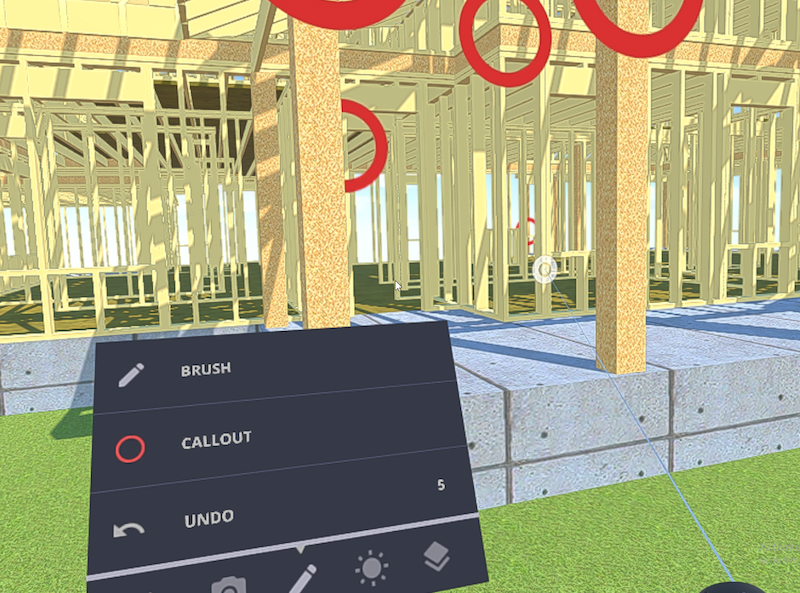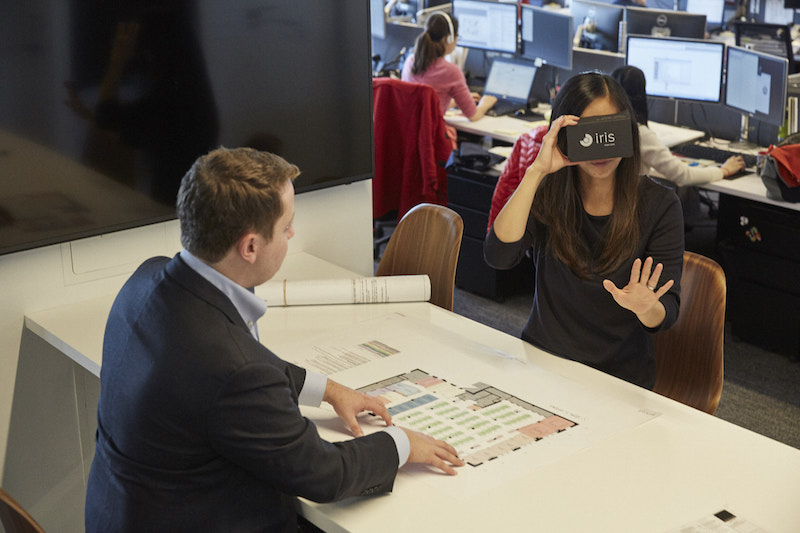Add to the growing list of tech companies that are integrating virtual reality into the architectural design process IrisVR, a startup platform that used this week’s Autodesk University event in Las Vegas to launch two products that allow AEC professionals to instantly visualize, explore, and share 3D models with virtual reality.
Its technology—which already has aroundn 20,000 users as a result of two years of beta testing—ets AEC pros curate VR walkthroughs, create life-like presentations, and interact with virtual models. The new products are:
•IrisProspect, a software program that installs plugins which enable users to send files created with the latest versions of Revit, SketchUp, OBJ, and Rhino directly into VR from one’s desktop. Prospect also allows users to quickly create immersive walkthroughs using Oculus Rift and HTC Vive.
•IrisScope allows users to upload, view, and share 360-degree panoramas with a mobile phone and Google Cardboard or Gear VR. Scope supports all leading pano formats, and is available for both iOS and Android devices.

IrisVR's Prospect software provides uses with the immersive walkthrough experience. Image: Courtesy of IrisVR
The basic package of these products is free (to download, click here). For $200 per month users can upgrade to a Pro account, which enhances Prospect with features such as dynamic lighting, annotations, screenshot capture and a scale model mode. The Pro account for Scope, at $40 per month, allows unlimited uploading and other features. IrisVR is offering a bundle of the Pro versions for $210 per month.
IrisVR is releasing these products after two years of extensive beta testing with partners such as Marmon Mok, which used Prospect to help the owner of University Hospital in San Antonio identify optimal patient movement and nurse site lines for infusion centers that the firm was designing. Before embarking on a major renovation of Loyola University Medical Center in suburban Chicago in February 2015, Mortenson Construction used Prospect to design and review with doctors and nurses how they would be using the new space.
“IrisVR gives us the ability to do something in the AEC world that we have never been able to do before: explore, refine, and explore again with full spatial understanding in an extremely compressed timeframe,” says Taylor Cupp, Project Solutions Technologists for the Minneapolis-based Mortenson, which worked with the architect VOA Associates and construction manager Hammes Co. on this project. (The renovation was completed last March.)
“Our virtual environments can be generated within seconds from multiple file formats and provide true-to-scale perspectives that both inspire design and reduce errors,” adds Shane Scranton, CEO and cofounder of IrisVR, whose team includes several AEC veterans. “We’re also seeing significant added value to our clients as they offer virtual reality as a selling point.”
The New York-based IrisVR recently secured $8 million in Series A funding, led by Emergence Capital, whose general partner Kevin Spain is on IrisVR’s board. The startup’s total funding to date is $10 million. Now, IrisVR will find out whether there’s a large enough market for it software, and—perhaps more important—whether the AEC and real estate communities are ready for it.
Related Stories
AEC Tech | Mar 14, 2023
Skanska tests robots to keep construction sites clean
What if we could increase consistency and efficiency with housekeeping by automating this process with a robot? Introducing: Spot.
Modular Building | Mar 3, 2023
Pallet Shelter is fighting homelessness, one person and modular pod at a time
Everett, Wash.-based Pallet Inc. helped the City of Burlington, Vt., turn a municipal parking lot into an emergency shelter community, complete with 30 modular “sleeping cabins” for the homeless.
AEC Tech | Jan 27, 2023
Epic Games' latest foray into the AEC market and real estate industry
From architecture to real estate, the realm of computer-aided design hits new heights as more and more firms utilize the power of Epic Games’ Twinmotion and Unreal Engine.
AEC Tech | Jan 27, 2023
Key takeaways from Autodesk University 2022
Autodesk laid out its long-term vision to drive digital collaboration through cloud-based solutions and emphasized the importance of connecting people, processes and data.
AEC Tech Innovation | Jan 24, 2023
ConTech investment weathered last year’s shaky economy
Investment in construction technology (ConTech) hit $5.38 billion last year (less than a 1% falloff compared to 2021) from 228 deals, according to CEMEX Ventures’ estimates. The firm announced its top 50 construction technology startups of 2023.
AEC Tech | Jan 19, 2023
Data-informed design, with Josh Fritz of LEO A DALY
Joshua Fritz, Leo A Daly's first Data Scientist, discusses how information analysis can improve building project outcomes.
AEC Tech Innovation | Jan 14, 2023
CES recognizes a Dutch firm’s wearable technology for construction management
The firm’s TokenMe product offers construction managers a real-time crowd- and asset-tracking solution via low-power, location-aware radio and RFID tags and multiple sensors through which data are processed with cloud-based artificial intelligence.
Digital Twin | Nov 21, 2022
An inside look at the airport industry's plan to develop a digital twin guidebook
Zoë Fisher, AIA explores how design strategies are changing the way we deliver and design projects in the post-pandemic world.
Giants 400 | Nov 14, 2022
4 emerging trends from BD+C's 2022 Giants 400 Report
Regenerative design, cognitive health, and jobsite robotics highlight the top trends from the 519 design and construction firms that participated in BD+C's 2022 Giants 400 Report.
Contractors | Nov 14, 2022
U.S. construction firms lean on technology to manage growth and weather the pandemic
In 2021, Gilbane Building Company and Nextera Robotics partnered in a joint venture to develop an artificial intelligence platform utilizing a fleet of autonomous mobile robots. The platform, dubbed Didge, is designed to automate construction management, maximize reliability and safety, and minimize operational costs. This was just one of myriad examples over the past 18 months of contractor giants turning to construction technology (ConTech) to gather jobsite data, manage workers and equipment, and smooth the construction process.

















